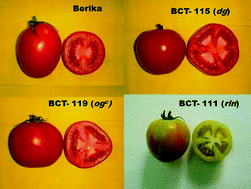Bioactive attributes of tomatoes possessing dg, ogc, and rin genes
Abstract
We present the results of the first study characterizing new tomato hybrids, possessing dark green (dg), old gold crimson (ogc), and ripening inhibitor (rin) genes, that determines the bioactive molecules and in vitro antioxidant potential of the peel and pulp of the fruits. The hybrids developed from Berika and BCT-115 (having the dg gene) were superior to those developed from BCT-119 and BCT-111 (carrying ogc and rin genes, respectively), in relation to their nutritional potential. A wide range (mg/100 g FW) of ascorbic acid (∼21–40), lycopene (∼2–4), β-carotene (∼0.5–1.7), total flavonoids (∼4.6–20.0), and total phenols (∼16–30) was recorded in the pulp. The peel fraction of the tomatoes was identified as an important reservoir of antioxidant bioactive compounds viz. lycopene (∼8–25), β-carotene (∼1.6–3.1), total flavonoids (∼42–82), and total phenols (∼59–83). The radical scavenging activity ranged from ∼45–78 and 21–50% in the peel and pulp, respectively, whereas the metal chelating activity was found to range from ∼23–42 and ∼15–26% in peel and pulp, respectively, among all the hybrids. This finding offers a new direction towards the development of new tomato hybrids that possess not only a good shelf life, but also a nutritional status as well. Moreover, utilizing tomato peel as a source of phytochemicals could offer diverse opportunities for nutraceutical and functional food applications.


 Please wait while we load your content...
Please wait while we load your content...